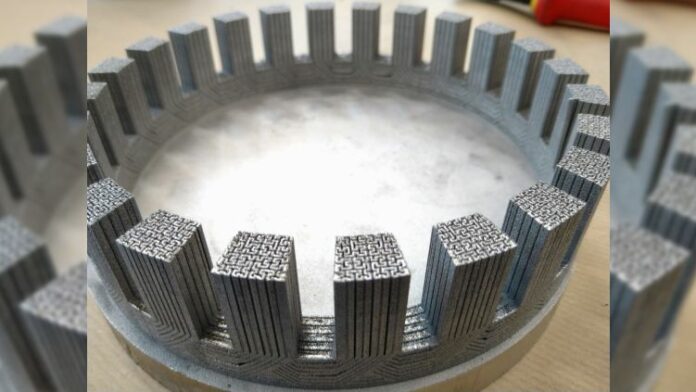We recently discovered the ability of Sheffield university researchers to use AM for rocket engine. Today, as part of a research that aims to develop electric motors with less material, those researchers joined forces with the University of Wisconsin-Madison to develop a 3D printed electric motor.
The prototype uses a higher-percentage silicon electrical steel that reduces energy losses. It consists of a stator, a circular-shaped object with prongs that wires can be wrapped around to create a magnetic field. The biggest design difference between the prototype and traditional stators can be seen in the prongs themselves, as they feature an intricate design of thin geometric lines meant to reduce energy loss.
When the printed prototype was tested in October 2022, it was found that it was giving more torque than they thought was possible with less material. “When you have 30% lower mass, you would expect that your torque would also be lower … but that wasn’t the case,” doctoral research assistant FNU Nishanth said. “So, this shows that you know you’re actually going to net torque density improvement in this machine and if we can further improve this, (making a more efficient motor) would be a game changer.”
Traditional methods of creating stators in electric motors use a lamination process, where sheets of electrical steel are stamped out. What you get as a result is a stator stacked with the laminations with tiny but visible ridge lines on the top of the prongs.
That method, though easily replicated, tends to rely on using an electrical steel alloy with 3% silicon in it, which lends to higher rates of energy loss and less efficiency. An electrical steel alloy made with 6.5% silicon, recommended by the U.S. Department of Energy, reduces energy losses but is more brittle and is less likely to withstand the traditional lamination process.
But with 3D printing, there’s no need for tons of pressure to be exerted during rolling and the machine can print the delicate pattern on the small 10-kilowatt prototype stator within 20 hours. While that wouldn’t be enough energy to run an electric vehicle, the model could be easily scaled up to reach 40 kilowatts and printed faster on an industrial printer.
This project will give lessons that will serve for the next phases of transportation electrification, for example for aeroplanes, where batteries will need to be lighter and motors will need to be more energy powerful.
Remember, you can post job opportunities in the AM Industry on 3D ADEPT Media free of charge or look for a job via our job board. Make sure to follow us on our social networks and subscribe to our weekly newsletter : Facebook, Twitter, LinkedIn & Instagram ! If you want to be featured in the next issue of our digital magazine or if you hear a story that needs to be heard, make sure to send it to contact@3dadept.com


